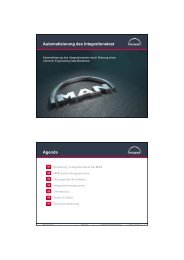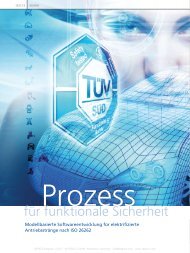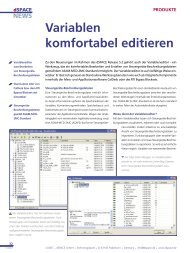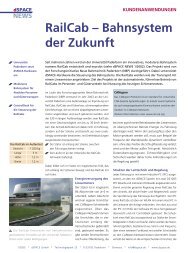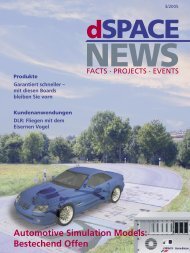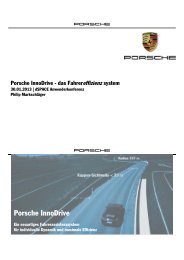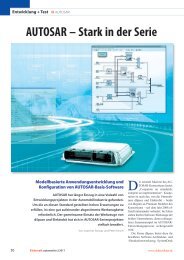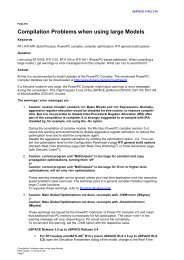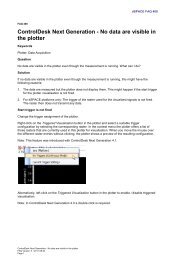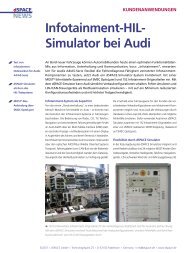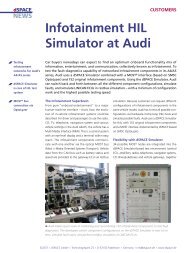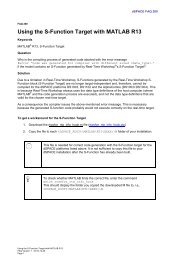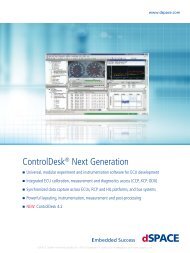magazinE - dSPACE
magazinE - dSPACE
magazinE - dSPACE
You also want an ePaper? Increase the reach of your titles
YUMPU automatically turns print PDFs into web optimized ePapers that Google loves.
held with specific suppliers.<br />
The need for coordination goes<br />
beyond just the software architecture,<br />
however. The OEM and the<br />
ECU supplier also have to jointly<br />
define the descriptions of metadata<br />
for integrating functions, such as the<br />
interface lists for the functions and<br />
the mapping of application signals<br />
to bus signals. Thus, the prerequisites<br />
for broader and processsafe use of<br />
modelbased development are a<br />
uniform, supplierindependent software<br />
architecture and a standardized<br />
description of the metadata.<br />
The aUTOSaR Software<br />
architecture<br />
The AUTOSAR standard defines a<br />
software architecture for ECUs, an<br />
integration method, and the interchange<br />
formats that these require.<br />
In other words, AUTOSAR largely<br />
addresses the requirements for the<br />
Fig. 2: Typical development cycle with multiple iterations.<br />
Requirements<br />
specification<br />
Daimler<br />
Supplier<br />
Test Specification<br />
model<br />
implementation model<br />
function<br />
modeling<br />
eCU SW<br />
development<br />
processsafe integration of modelbased<br />
functions described above.<br />
AUTOSAR divides the application<br />
software of an ECU into several software<br />
components (SWCs), which<br />
communicate with one another via<br />
middleware (the runtime environment,<br />
or RTE). SWCs encapsulate<br />
the software and give it type definitions,<br />
allowing data exchange only<br />
via welldefined interfaces.<br />
Two mapping steps are needed for<br />
integration on an ECU: First the<br />
SWC instances are mapped to ECUs,<br />
and then the data elements are<br />
mapped to network signals for<br />
communication across ECUs.<br />
Strategy for introducing<br />
aUTOSaR<br />
For the next generation of vehicle<br />
interior ECUs, Daimler AG is taking<br />
the first step towards an AUTOSAR<br />
architecture. The introduction<br />
Main Function Development<br />
process starts at the top of the layer<br />
model for AUTOSAR software architectures<br />
and works its way down,<br />
i.e., it begins with the application<br />
software components (SWCs) and<br />
the RTE (fig. 3). This will involve<br />
systematically dividing the software<br />
architecture into application parts<br />
and basic software parts, which will<br />
communicate via a defined interface.<br />
The basis for defining this<br />
interface is the AUTOSAR standard,<br />
though this is partially restricted here<br />
and has also been more precisely<br />
formulated at some points. In this<br />
first step, the standard software will<br />
still be based on the established<br />
Daimler Standard Core, to which<br />
selected AUTOSAR software services<br />
(such as memory management for<br />
NVRAM data) will be added.<br />
In this early phase, the ECUs<br />
developed in this way will still be<br />
networkcompatible with ECUs<br />
function<br />
function<br />
Review Review Review<br />
modeling<br />
modeling<br />
function<br />
implementation<br />
& integration<br />
Component &<br />
hil & vehicle<br />
Testing<br />
eCU SW<br />
development<br />
Release 1 … m Release m+1 … n Release n+x<br />
Optimization<br />
function<br />
implementation<br />
& integration<br />
Component &<br />
hil & vehicle<br />
Testing<br />
ECU<br />
eCU SW<br />
development<br />
pAGe 9



